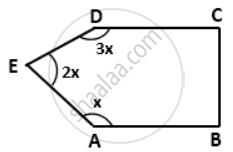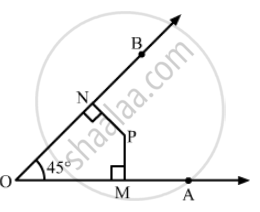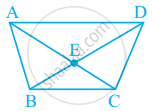Advertisements
Advertisements
प्रश्न
ABCDE is a pentagon in which AB is parallel to DC and ∠A : ∠E : ∠D = 1 : 2 : 3. Find angle A.
उत्तर

Given AB || DC
⇒ ∠B + ∠C = 180°
Also,
∠A : ∠E : ∠D = 1 : 2 : 3
⇒ ∠A = x, ∠E = 2x and ∠D = 3x
Since,
∠A + ∠B + ∠C + ∠D + ∠E = (5 - 2) x 180°
⇒ ∠A + (∠B + ∠C) + ∠D + ∠E = 3 x 180°
⇒ x + 180° + 3x + 2x = 540°
⇒ 6x + 180° = 540°
⇒ 6x = 360°
⇒ x = 60°
Hence,
∠A = 60°.
APPEARS IN
संबंधित प्रश्न
In Fig. 16.20, find the measure of ∠MPN.

PQRSTU is a regular hexagon. Determine each angle of ΔPQT.
Complete the following statement by means of one of those given in brackets against each:
If in a quadrilateral only one pair of opposite sides are parallel, the quadrilateral is ................
If ABCD is a rectangle with ∠BAC = 32°, find the measure of ∠DBC.
In quadrilateral PQRS, ∠P : ∠Q : ∠R : ∠S = 3 : 4 : 6 : 7.
Calculate each angle of the quadrilateral and then prove that PQ and SR are parallel to each other
(i) Is PS also parallel to QR?
(ii) Assign a special name to quadrilateral PQRS.
In a trapezium ABCD, side AB is parallel to side DC. If ∠A = x° and ∠D = (3x – 20)°; find the value of x.
In a pentagon ABCDE, AB || ED and ∠B = 140°, ∠C = 2x° and ∠D = 3x°. Find ∠C and ∠D
The angles of a quadrilateral are in the ratio 2 : 4 : 5 : 7. Find all the angles
Both the pairs of opposite angles of a quadrilateral are equal and supplementary. Find the measure of each angle.
In given figure, What is BD – BE?
